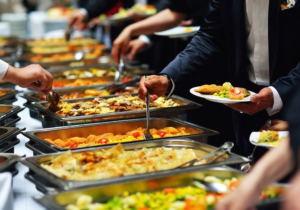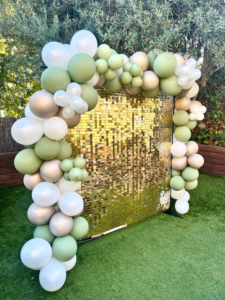A barbecue is a social event centered around smoked meat. It can involve pork, chicken, fish, or anything else cooked on a grill or in an earth dug-pit.
Classic BBQ meats are full of tough collagen – the sinewy protein that makes up most animal muscles. When collagen melts, it releases long molecules of water vapor that produce smoke. Contact Chandler BBQ now!

The term bbq (pronounced barb-ee) can mean several things. It can refer to the cooking technique, the meat prepared this way, or even the event, usually a social gathering, at which food is barbecued. It is a word that evokes the idea of smoke and flame and, in popular culture, is embodied by many iconic images, including Homer Simpson eating hot dogs and President Lyndon Johnson having his beef stewed on a barbeque.
The word itself translates the Taino word barbacoa, which means “grill.” The Taino were Arawak people who inhabited parts of what are now the Caribbean and Florida. They had a tradition of roasting meat on a raised wooden grate over a fire called a pitacoa or barbacoa. This method of preserving and roasting meat was so successful that it spread throughout the Caribbean, Latin America, and even to the English colony of Virginia.
In the US, the popularity of barbecue was fueled by the expansion of slavery throughout the South. The practice of using an earth-dug pit to cook whole animals, as illustrated by the photograph of President Lyndon Johnson having his steak barbecued this way in 1967, was common in cotton plantations. This is what brought BBQ to the mainstream.
It was around this time that splinters of regional styles and sauces began to appear. For example, mustard-style sauces were first developed in areas with a heavy concentration of German and French immigrants, while vinegar-based sauces, like the classic Tennessee sauce, appeared where there were British influences.
A newer method of barbecue, which is now the standard in most Southern restaurants and is the foundation of grilling techniques across the US, involves putting meat over direct heat on an open flame. This is not true barbecue as defined by the USDA, which regulates the production of food that travels across state lines and for export. The USDA defines barbecue as a cooked meat product that has been exposed to direct, intense heat for an extended period of time. The indirect heat used in a smoking oven qualifies as barbecue, but an over-the-fence grilled burger does not.
Techniques
There are a number of techniques that can be used to prepare bbq. The main thing that distinguishes barbecue from other methods of cooking is smoke. Although it can be difficult to define the word barbecue, one popular definition is that it is a style of cooking that uses an open flame and indirect heat, with the food being cooked slowly and with a lot of smoke. This is why grilled meats are often called barbecue, although some people will also include boiled and baked dishes in this category. Many different cuisines have their own variations of barbecue, including Argentine asado, Chinese barbeque, Korean bulgogi, Japanese yakiniku, St. Maarten lolo, Mexican barbacoa, Brazilian churrasco, Hawaiian poke, South African braai, Greek arni kleftiko and Indian tandoori.
The most common technique is direct cooking, which involves placing the food directly over the heat source. This is the preferred method for foods that require a quick, intense heat, such as steaks and burgers. It is not suitable for foods that need to be cooked more slowly, such as whole chickens and large cuts of meat, which will burn if they are exposed to the heat for too long. Indirect cooking can be achieved by banking the coals on either side of the grill or using two burners on a gas grill.
Another way to achieve indirect cooking is by using a rotisserie. This can be done on a traditional or electric grill. It is important to rest the meat before putting it on the rotisserie so that the juices can flow back into the muscle tissue and make the meat juicy.
Some people try to shrink the definition of barbecue to exclude anything that is not cooked over an open flame or in an open pit. But this type of revisionist snobbery is unfair to the cooks who developed the art and the people who have been most influential in its spread.
To create a true barbecue, it is essential to use the right temperature and to know how to test for doneness. A simple touch of the thumb to the pad at the base of the index finger will tell you whether or not your meat is ready to eat. If it is overcooked, the meat will be dry and tough. If it is undercooked, it will be mushy and taste bland.
Sauces
There is no barbecue without a sauce, and the best barbecue sauce will add acidity, sweetness, smoke and a blend of other flavors to grilled meats. It will also complement the flavor of vegetables and sides. The most popular sauces include ketchup and vinegar, honey and sugar, tomato sauce, mustard, and other spices. Several regional styles of sauce have evolved, such as playground yellow mustard sauces of South Carolina and Big Bob Gibson’s mayo-based Alabama white sauce.
In addition to being a condiment, barbecue sauce can be used as a marinade for grilled pork or beef brisket. It can also be brushed on during the last few minutes of grilling. Sauces can be made with a variety of ingredients, including tomato sauce, ketchup, brown sugar and molasses, onion powder, garlic powder, apple cider vinegar, and cayenne pepper.
Tomato-based BBQ sauces are the most common and can be found in any supermarket. They can range from sweet and tangy to smoky and spicy. The thicker, ketchup-based varieties are best with ribs and chicken. Vinegar-based sauces are more appropriate for pulled pork and whole hog barbecue, as the subtleties of these meats can be overwhelmed by the tangy sweetness of tomato sauces.
Eastern-style barbecue sauces typically consist of vinegar and a little bit of sugar. They are often thicker than other sauces, making them suitable for use as a marinade or mop sauce. Mop sauce is used to baste barbecue as it cooks, and pitmasters will often keep a bowl of the sauce on hand to do just that.
The simplest recipe for BBQ sauce uses six ingredients that are usually on hand in most kitchens. Ketchup provides the base, Worcestershire sauce contributes umami, light brown sugar brings sweetness, and vinegar adds tang. To this mix, some recipes call for the addition of liquid smoke and spices such as paprika, salt, and cayenne pepper. This homemade barbecue sauce is easy to prepare and can be used as a dipping sauce or as a marinade for BBQ chicken, burgers, or steaks. It can also be used as a condiment on sandwiches or salads.
Restaurants
There’s nothing quite like the taste of a melt-in-your-mouth piece of meat with just the right sauce to make your mouth water. That’s why barbecue lovers are willing to go out of their way for it, and why they flock to restaurants that specialize in the art of smoked meats. These restaurants know what they’re doing, and they’re not afraid to show off: glistening briskets slow-cooked over wood coals, pork chops dripping with melty flavors, racks upon racks of fatty, cherry red spare ribs, all served in places where you can get your carnivorous fix without leaving town.
While Texas is a natural home for barbecue, it’s also true that some people have a special love for the style—enough to devote themselves to the practice and create unique restaurants. Take ZZQ, a pitmaster-owned joint that opened in Richmond, Virginia. While the restaurant has a no-nonsense approach to classic dishes, such as beef brisket and pulled pork, it also has a menu that leans toward eclecticism. Dishes like the smoked duck confit with juniper berry sauce and the Beef N Cheddar sandwich are a testament to the restaurant’s devotion to the craft of barbecue.
Other restaurants have a more straightforward approach to the barbecue tradition. Cattleack, in Brooklyn, is a maverick operation that serves a dizzying array of smoky meats over wood coals. In addition to the standard fare of brisket and ribs, it offers beef tongue pastrami, pork belly, veal heart, and even pigtails. And if that’s not enough to keep your stomach grumbling, the kitchen puts out a serious drink program, with shots of premium whiskey.
Virgil’s Real BBQ, across from New York City’s Grove Street PATH station in Jersey City, is another destination for barbecue lovers. Its surprisingly large selection includes:
- Meat-stacked sandwiches.
- A meaty barbecue bowl.
- Big ol’ party trays perfect for a carnivorous gathering.
The restaurant is also a great place to start the day, with breakfast tacos and biscuits for breakfast and lunch.

